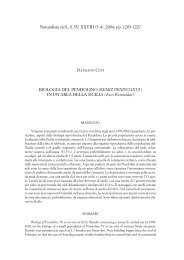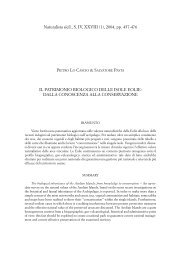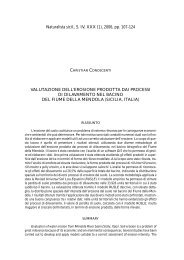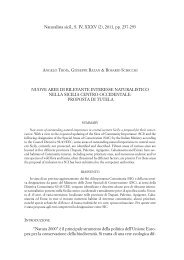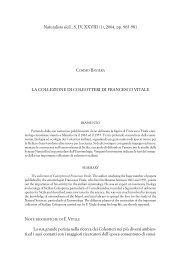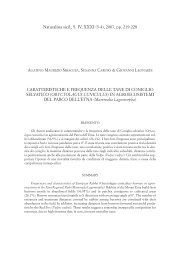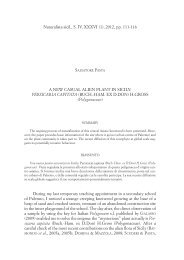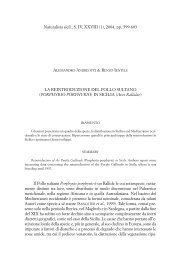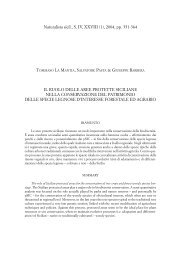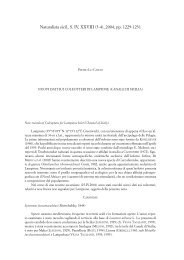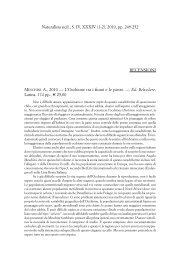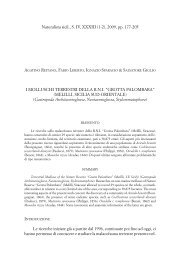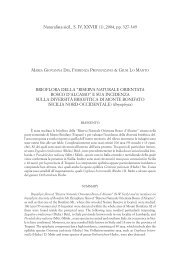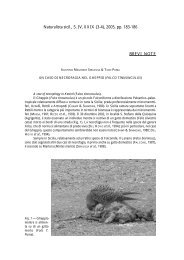2007,pp - Società Siciliana di Scienze Naturali
2007,pp - Società Siciliana di Scienze Naturali
2007,pp - Società Siciliana di Scienze Naturali
You also want an ePaper? Increase the reach of your titles
YUMPU automatically turns print PDFs into web optimized ePapers that Google loves.
Gall midges (Diptera Cecidomyiidae) of Sicily<br />
285<br />
Lasioptera eryngii (Vallot, 1829)<br />
Larvae cause plurilocular swellings on stems, leaf petioles and main leaf<br />
veins of Eryngium campestre L. (Apiaceae) (Pl. II, Fig. 10). The walls of chambers<br />
are covered with fungal mycelium. Larvae pupate in galls. Two generations<br />
develop per year. Occurrence: DE STEFANI (1905a, 1905c, 1906c) found<br />
galls on Eryngium tricuspidatum, E. campestre and E. amethystinum in Palermo<br />
and reared from them several parasitoids. DE STEFANI jr (1942) reported<br />
galls also from Santa Ninfa (Trapani); recent records of galls on E. campestre:<br />
Sciare <strong>di</strong> Marsala (Trapani), 10.8.2006, leg. B. Massa; Piana degli Albanesi<br />
(Palermo), 17.8.<strong>2007</strong>. Distribution: Me<strong>di</strong>terranean; it was found also in<br />
Turkey (SKUHRAVÁ et al., 2005).<br />
Lasioptera thapsiae Kieffer, 1898,<br />
Larvae cause plurilocular swellings at the point of insertion of the umbellules<br />
of Thapsia garganica L. (Apiaceae), of a size of a walnut (Pl. II, Fig. 12).<br />
Two generations develop per year. Larvae pupate in the galls. Occurrence: DE<br />
STEFANI (1903) found galls in the mountains surroun<strong>di</strong>ng Palermo very abundantly<br />
and later he obtained several parasitoids from them (DE STEFANI,<br />
1905a). Recently (6.6.<strong>2007</strong>) the galls were found on Ustica Is., where they seem<br />
very abundant (leg. S. Pasta). Reference: TROTTER & CECCONI (1900-1917: N.<br />
290), Palermo, 1902, leg. De Stefani. Distribution: Me<strong>di</strong>terranean.<br />
Lasioptera umbelliferarum Kieffer, 1909<br />
Larvae cause plurilocular swellings on stems and leaf stalks of Hi<strong>pp</strong>omarathrum<br />
sp. (formerly Seseli) (Apiaceae), up 20 mm long. Galls were <strong>di</strong>scovered<br />
at Petrowsk near the Caspian Sea in 1894 by Rübsaamen (RÜBSAA-<br />
MEN, 1895) and afterwards KIEFFER (1909) described the species very<br />
briefly. Occurrence: MÖHN (1969-1971) examined larvae of this species<br />
coming from S. Martino near Palermo, 600 m, 31.5.1840 (Coll. Möhn, N.<br />
8150). Distribution: Euro-Asian, galls are known to occur in southern Italy<br />
(Sicily), Russia (Petrowsk near the Caspian Sea), Georgia, Iran (Kur<strong>di</strong>stan)<br />
and Palestine.<br />
Lesto<strong>di</strong>plosis aoni<strong>di</strong>ellae Harris, 1968<br />
Adults were reared from larvae preying on Aoni<strong>di</strong>ella aurantii<br />
(Hemiptera Diaspi<strong>di</strong>dae) on Citrus aurantii (Rutaceae) in South Africa. SIS-<br />
CARO et al. (1999) found this species in eastern Sicily during observations on<br />
the natural enemies of Aoni<strong>di</strong>ella aurantii in citrus groves. This species was<br />
probably introduced in Sicily from Africa and may be evaluated as alien<br />
species in Sicily and Italy.



